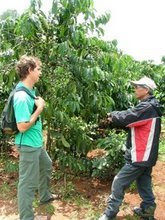The Barista Realtors Of Tel Aviv
Are you a Realtor that's been racking your brain for clever ways to get clients to come to you? Ways to trim the cost of the celebratory luncheon? Eliminate cold calls? Cut down on driving time? Sure you are. And though technology seems to be the answer to almost everything these days, in many cases it's not. The answer my friends, is in coffee.
What's coffee have to do with real estate? Well if you're Yaffa Goan, the two are inextricably and profitably intertwined. This clever Tel Aviv businesswoman had the good sense to compensate for the shortcomings of both coffee and real estate by combining the two when she turned her neighborhood cafe into a real estate cafe. The result is a little bit of chocolate in the peanut butter/peanut butter in the chocolate kind of ingenuity that makes the world of commerce go round.
In his book, "Think like a Billionaire", Donald Trump had this to say about the business of real estate: "Real estate is at the core of almost every business, and it's certainly at the core of most people's wealth. In order to build your wealth and improve your business smarts, you need to know about real estate."
It seems that Goan really took his advice to heart when she literally put real estate at the core of her cafe business. Though the shop has always been hopping, for years, it's been hot properties, not hot coffee advertised in the front window. When they walk in, patrons encounter some mind expanding contradictions. Steam rises from the gleaming espresso machine to the left of the receptionist's desk; a smattering of art and a row of framed real estate licences decorate the wall behind the counter; couples chat across solid wood cafe tables where Goan's team of fully trained barista-realtors are ready to serve them a latte or sell them a condo with equal ease. What is this place? Well, pull up a chair, order your latte and make a deal in one of the world's first real estate cafes.
You may ask yourself why this strange union works, but the answers are obvious.
You see, people love coffee. It's a staple of our daily social diets. Fun to make, fun to drink, with artful designs skillfully rendered in the foamed milk. It's great, it costs a dollar, who can argue? Well, if you're the one counting the till at the end of the night, you might argue. Even at specialty prices, you have to sell an awful lot of coffee to turn a decent profit. You have to work hard, the hours are long. Opening a cafe is not a get rich quick scheme.
On the other hand, there's real estate - the most reliable way to build wealth in our times. It's the high stakes game that all the rich kids like to play. But unless you're a Realtor, hanging out at your local real estate office is a bit eccentric to say the least. Though exciting in many ways, a real estate office is not your typical social hotspot.
For Goan, blending the social aspect of the cafe with the speculative appeal of real estate has been a successful move. Her cosy real estate cafe works because it's a brilliant way to bring clients in, cut costs and operate a second business all at the same time. Want to talk business over a cup of coffee? Well sit right down. "When we need to close deals, we do it here," she says, "over a cup of coffee, a meal, on the house."
By: Justin Havre
Article Directory: http://www.articledashboard.com
A Pan to Roast Your Food - Cooking the Simple Way
15 ปีที่ผ่านมา







































